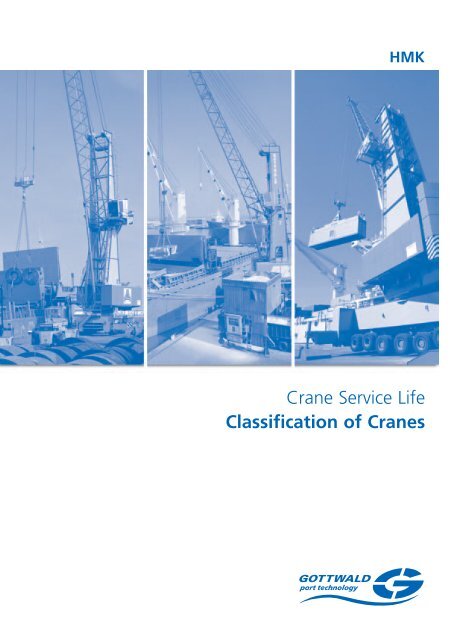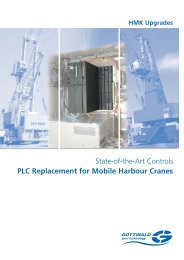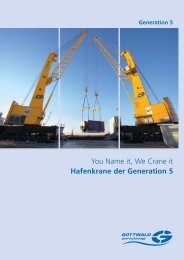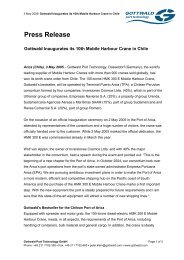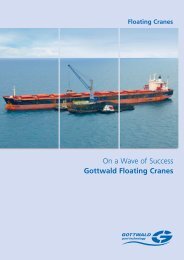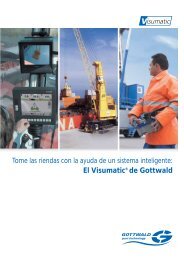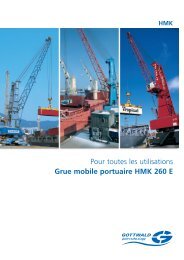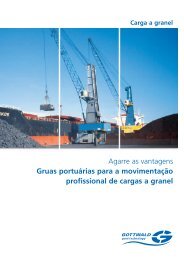Crane Service Life Classification of Cranes - Gottwald Port Technology
Crane Service Life Classification of Cranes - Gottwald Port Technology
Crane Service Life Classification of Cranes - Gottwald Port Technology
Create successful ePaper yourself
Turn your PDF publications into a flip-book with our unique Google optimized e-Paper software.
HMK<br />
<strong>Crane</strong> <strong>Service</strong> <strong>Life</strong><br />
<strong>Classification</strong> <strong>of</strong> <strong>Crane</strong>s
<strong>Service</strong> <strong>Life</strong> <strong>of</strong> <strong>Crane</strong>s –<br />
A Brief Explanation <strong>of</strong> the Basic Terms<br />
<strong>Classification</strong> <strong>of</strong> <strong>Crane</strong>s according to FEM 1.001<br />
Two crucial aspects need to be<br />
kept in mind when weighing up<br />
the options before purchasing<br />
material handling equipment,<br />
such as a Mobile Harbour <strong>Crane</strong>:<br />
the maximum handling rates <strong>of</strong><br />
the crane and its total intended<br />
duration <strong>of</strong> use (“service life”).<br />
While great importance is attached<br />
to the maximum handling rates in<br />
the decision to purchase, too little<br />
focus is placed on an assessment<br />
<strong>of</strong> the crane’s service life.<br />
For this reason, the basic interrelationships<br />
and factors influencing<br />
the service life <strong>of</strong> a Mobile<br />
Harbour <strong>Crane</strong> are explained<br />
below.<br />
What Do we Really Mean by<br />
<strong>Service</strong> <strong>Life</strong>?<br />
When a component or an entire<br />
unit, such as a crane, is excessively<br />
overloaded, it will fail at once.<br />
However, by far the more relevant<br />
cause <strong>of</strong> the damage is failure <strong>of</strong><br />
the crane due to use beyond its<br />
service life.<br />
Each individual work cycle <strong>of</strong> a crane<br />
(even if the load lifted is far below<br />
the crane’s maximum lifting capacity)<br />
contributes to component fatigue. If<br />
a load is applied <strong>of</strong>ten enough, the<br />
component fails even if the individual<br />
loads alone did not lead to the failure.<br />
The Paper Clip Experiment<br />
Take a paper clip in your hand and<br />
try to tear it apart. It will not be<br />
possible. However, if you bend it<br />
back and forth several times, even<br />
a relatively small force is sufficient to<br />
break it. As a result <strong>of</strong> the repeated<br />
loading, the useful life <strong>of</strong> the paper<br />
clip is exceeded because, as with<br />
most components in technical<br />
applications, it was designed for a<br />
finite service life that is not based<br />
on fatigue endurance.<br />
With the help <strong>of</strong> this simple<br />
experiment it is easy to understand<br />
that both the intensity <strong>of</strong> the stress<br />
(i.e. how powerfully the paper clip<br />
was bent back and forth) and the<br />
number <strong>of</strong> bends (“work cycles”)<br />
are relevant for the time at which<br />
the failure occurs.<br />
However, how would a paper clip<br />
made <strong>of</strong> thicker wire behave?<br />
Experience from everyday life teaches<br />
us that it would have lasted longer.<br />
Another aspect for evaluating the<br />
service life is thus the durability<br />
(“loading capacity”) for which a<br />
component has been designed.<br />
Two fundamental elements are<br />
decisive for evaluating the service life<br />
<strong>of</strong> a component or a crane: the load<br />
and the loading capacity. The service<br />
life (Figure 1) is a result <strong>of</strong> the<br />
interplay <strong>of</strong> these two components.<br />
Figure 1<br />
Effects <strong>of</strong> Loading<br />
The loads acting on a Mobile Harbour<br />
<strong>Crane</strong> during operation are not<br />
constant. A distinction is made<br />
between different modes <strong>of</strong> operation<br />
(heavy load operation, container<br />
operation, grab operation, etc.),<br />
in which very different loads occur<br />
(empty containers – full containers,<br />
empty grabs – full grabs, etc.).<br />
It is, therefore, not possible to assume a<br />
constant load for the crane. As a result,<br />
the standards according to which a<br />
crane is designed (e.g. FEM 1.001) define<br />
the loading spectrum by means <strong>of</strong><br />
which an attempt is made to describe<br />
the actual load applied to a crane.<br />
How is a Loading Spectrum<br />
Determined?<br />
To accurately determine a loading<br />
spectrum for a particular crane, a<br />
statistical random check is used.<br />
Readings are taken, for example,<br />
thousand cycles for a container<br />
handling crane and a crane equipped<br />
with grab (50 t lifting capacity in each<br />
case) as shown in Figure 2.<br />
On the basis <strong>of</strong> these random checks,<br />
it is then possible to determine the<br />
loading spectrum <strong>of</strong> the crane<br />
examined. However, since the exact<br />
distribution <strong>of</strong> loads in practice is not<br />
known in advance, crane manufacturers<br />
must apply different criteria<br />
when designing a crane.<br />
The standard on which the crane<br />
calculation is based, i.e. FEM 1.001,<br />
makes it possible to estimate the<br />
future loading <strong>of</strong> a crane and select<br />
one <strong>of</strong> four standardised loading<br />
spectra. The standardised load<br />
spectrum classes range from Q1<br />
(“crane predominantly lifts low loads<br />
and only rarely maximum permissible<br />
loads”) to Q4 (“crane frequently lifts<br />
loads equal to its maximum lifting
Number <strong>of</strong> cycles<br />
350<br />
300<br />
250<br />
200<br />
150<br />
100<br />
50<br />
0<br />
Figure 2: Determination <strong>of</strong> the loading spectra<br />
Container operation<br />
Grab operation<br />
10 14 18 22 26 30 34 38 42 46 50<br />
capacity”). Therefore, the decisive<br />
factor for selection <strong>of</strong> a spectrum<br />
class is how frequently a crane has<br />
to lift heavy loads (in comparison to<br />
the maximum load in the mode <strong>of</strong><br />
operation examined).<br />
The diagram in Figure 2 clearly<br />
shows that a crane equipped with<br />
a grab, for example, is subjected<br />
to significantly higher loads than a<br />
container-handling crane because<br />
heavy loads occur at a higher<br />
frequency (the crane driver almost<br />
always fills the grab completely with<br />
bulk material). A crane fitted with<br />
a grab must therefore always be<br />
classified in the highest spectrum class.<br />
Loading capacity<br />
While loading is a characteristic<br />
<strong>of</strong> crane operation, the loading<br />
capacity is a characteristic <strong>of</strong> the<br />
crane construction. When a crane is<br />
designed, a certain crane classification<br />
is selected by the manufacturer and<br />
the crane is designed according to<br />
this classification.<br />
FEM 1.001 <strong>of</strong>fers a choice <strong>of</strong> eight<br />
group classifications (A1 to A8). In<br />
the example above with the service<br />
life <strong>of</strong> a paper clip, we noted that the<br />
thickness <strong>of</strong> the wire is a determining<br />
Weight [t]<br />
factor for the service life. In the steel<br />
structure <strong>of</strong> a crane the same applies.<br />
To put it in very simplified form:<br />
The higher the number <strong>of</strong> the crane<br />
group, the thicker the steel sheet and<br />
tubing used and the more robust the<br />
crane.<br />
<strong>Service</strong> <strong>Life</strong><br />
If the loading capacity (crane group)<br />
and the expected load (spectrum<br />
class) are known, the service life<br />
(class <strong>of</strong> utilisation) <strong>of</strong> the crane can<br />
be determined on that basis.<br />
According to FEM 1.001, this will<br />
give us a class <strong>of</strong> utilisation from<br />
U0 to U9 and thus an indication <strong>of</strong><br />
how many work cycles the crane will<br />
manage before the end <strong>of</strong> its service<br />
life is reached. Towards the end <strong>of</strong><br />
the service life, the probability <strong>of</strong><br />
failure increases rapidly with further<br />
operation. The relationship between<br />
the sizes, crane group, spectrum<br />
class and service life is illustrated in<br />
Figure 3 and Table 1. If we now<br />
compare a crane in crane group A8<br />
to a crane in crane group A6 with<br />
regard to service life, it is easy to<br />
determine on the basis <strong>of</strong> the diagram<br />
how long the useful life <strong>of</strong> each one<br />
will be.<br />
Load on ropes [t]<br />
Container<br />
discharging<br />
crane<br />
No. <strong>of</strong> cycles<br />
<strong>Crane</strong> fitted<br />
with grab<br />
10 0 0<br />
12 0 0<br />
14 15 0<br />
16 181 0<br />
18 63 35<br />
20 30 0<br />
22 43 0<br />
24 45 0<br />
26 42 0<br />
28 37 0<br />
30 45 0<br />
32 64 0<br />
34 86 3<br />
36 138 7<br />
38 101 13<br />
40 57 30<br />
42 37 40<br />
44 12 87<br />
46 3 170<br />
48 1 315<br />
50 0 300<br />
If both cranes are used for the same<br />
type <strong>of</strong> application, the same spectrum<br />
class applies to both cranes. If this<br />
class is specified as Q3, it can be<br />
seen that the crane classified in A8<br />
will have a service life <strong>of</strong> more than<br />
4,000,000 work cycles whereas the<br />
crane classified according to A6 will<br />
reach the end <strong>of</strong> its service life after<br />
only 500,000 work cycles.<br />
The crane with the higher classification<br />
thus has a useful life that is over four<br />
times longer given the same loads!<br />
As a rule <strong>of</strong> thumb, one can state on<br />
the basis <strong>of</strong> the diagram in Figure 3.<br />
Given the same loads, an increase in<br />
the crane group by one level (e.g.<br />
from A6 to A7) corresponds to a<br />
doubling <strong>of</strong> the expected useful life.<br />
<strong>Crane</strong>s that have been classified in<br />
the highest crane group, A8, are<br />
designed such that the loads on the<br />
components during operation are so<br />
low that theoretically no fatigue is<br />
caused by such operation.<br />
Consequently, a crane classified in<br />
crane group A8 does not have a<br />
limited service life and will have an<br />
unlimited fatigue endurance.
<strong>Service</strong> life (in million work cycles)<br />
4.0<br />
3.5<br />
3.0<br />
2.5<br />
2.0<br />
1.5<br />
1.0<br />
0.5<br />
Subjects to change without notice<br />
Figure 3: Relationship between crane group and useful life<br />
Table 1<br />
Loading<br />
spectrum<br />
class<br />
fatigue endurance range<br />
range <strong>of</strong> fatigue strength for finite life<br />
A1 A2 A3 A4 A5 A6 A7 A8<br />
<strong>Crane</strong> group<br />
Class <strong>of</strong> utilisation and duration <strong>of</strong> use (number <strong>of</strong> work cycles)<br />
U0 U1 U2 U3 U4 U5 U6 U7 U8 U9<br />
16,000 32,000 63,000 125,000 250,000 500,000 1 m 2 m 4 m > 4 m<br />
Q1 A1 A1 A1 A2 A3 A4 A5 A6 A7 A8<br />
Q2 A1 A1 A2 A3 A4 A5 A6 A7 A8 A8<br />
Q3 A1 A2 A3 A4 A5 A6 A7 A8 A8 A8<br />
Q4 A2 A3 A4 A5 A6 A7 A8 A8 A8 A8<br />
<strong>Gottwald</strong> <strong>Port</strong> <strong>Technology</strong> GmbH • P.O. Box 18 03 43 • 40570 Düsseldorf, Germany<br />
Phone: +49 211 7102-0 • Fax: +49 211 7102-3651 • info@gottwald.com • www.gottwald.com<br />
Q1<br />
Q2<br />
Q3<br />
Q4<br />
U8<br />
U7<br />
U6<br />
U5<br />
U4<br />
...<br />
<strong>Classification</strong> 01/07.03 UK S+S


